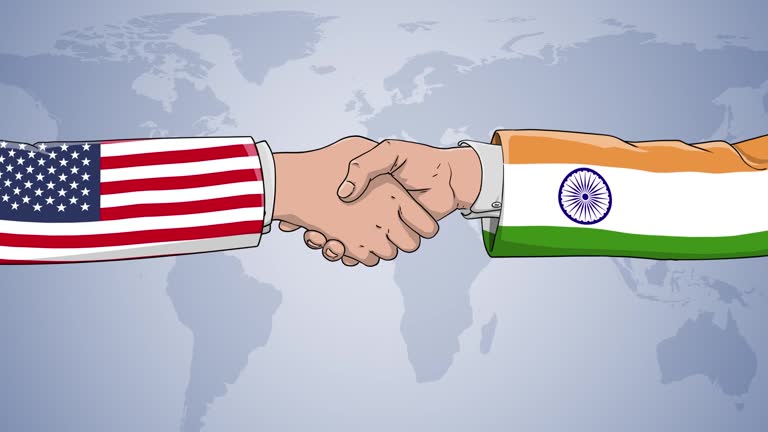US-India Relations Critical: Senator Vance Predicts ‘Dark Time’ If Ties Fade

US-India Relations Critical,during a visit to Jaipur on Tuesday, US Vice President JD Vance outlined America’s plan to strengthen relations with India through increased energy exports and defense equipment sales. The high-profile visit comes as both nations make progress on a bilateral trade agreement.
Key Highlights from Vance’s Visit:
- Praised Prime Minister Narendra Modi’s leadership multiple times
- Contrasted India’s “vitality” with what he called the “sameness” of Western nations
- Positioned energy and defense as cornerstone sectors for partnership
- Addressed ongoing trade negotiations between the two countries
Context Behind the Visit:
The diplomatic outreach occurs despite recent tensions over:
✓ US criticism of India’s high tariffs on automobiles and agricultural products
✓ Differences in trade policy approaches
✓ Ongoing negotiations to balance both nations’ economic interests
Why This Matters:
- Strategic Partnership: Energy and defense represent two of the most significant areas for US-India collaboration
- Economic Potential: Successful trade talks could open new markets for both countries
- Geopolitical Timing: Comes amid shifting global alliances and supply chain realignments
Local Perspective:
Vance’s choice of Jaipur – a growing hub for technology and traditional industries – signals America’s interest in engaging with India beyond its major metropolitan centers. His remarks about India’s “vitality” appear aimed at resonating with domestic audiences while acknowledging the country’s economic growth.
Senator JD Vance (R-Ohio) believes India stands to gain significantly from shifting global trade patterns, telling an audience in Jaipur that Trump-era tariffs could create “great benefits for the people of India.”
Speaking to hundreds of students, business leaders, and government officials, Vance positioned India as the prime candidate to replace China as the world’s manufacturing hub, especially as U.S. tariffs make Chinese exports less competitive.
Key Takeaways from Vance’s Speech:
✅ Opportunity for India: “This trade rebalancing could transform India into the world’s factory floor”
✅ Stakes of Partnership: “A strong US-India alliance could define a prosperous 21st century”
✅ Urgent Warning: Without cooperation, Vance predicts “a very dark time for all of humanity”
Why This Matters Now:
- U.S. tariffs on China currently exceed 25% on $300B+ goods
- India’s manufacturing sector grew 4.7% last quarter
- Bilateral trade hit $191B in 2023, up 7.65% YoY
The Bigger Picture:
Vance’s comments come as:
• Apple shifts 18% of iPhone production to India
• Micron begins 2.75Bsemiconductorplantconstruction•GEAerospaceannounces2.75Bsemiconductorplantconstruction•GEAerospaceannounces1B India manufacturing deal.
During his four-day family visit to India, Senator JD Vance (R-Ohio) emphasized the growing strategic partnership between the two nations, highlighting three key areas of collaboration:
1. Defense Cooperation
Vance suggested India could naturally expand its purchases of American military equipment, specifically mentioning Lockheed Martin’s advanced F-35 fighter jets. “We conduct regular joint exercises — it makes sense to deepen our defense partnership further,” he stated. The Senator openly expressed America’s interest: “We want to work together more, and we want India to consider more U.S. military equipment for its modernization needs.”
2. Energy Partnership
The discussion covered multiple energy opportunities:
- U.S. energy exports to India
- Joint exploration of India’s offshore natural gas reserves
- Collaboration on critical mineral supplies
- Nuclear energy cooperation
3. Personal Connections
Accompanied by his wife (daughter of Indian immigrants) and their three children, Vance’s visit blended diplomacy with family heritage. This personal dimension adds warmth to the strategic dialogue.
Trade Context:
The talks come as India seeks to finalize a trade agreement with its largest partner before the 90-day pause on Trump-era tariffs expires. Both nations appear motivated to strengthen economic ties despite past trade tensions.
US Senator JD Vance (R-Ohio) praised Indian Prime Minister Narendra Modi as “a special person” during recent remarks, while criticizing past American approaches to India relations.
“I think he’s a special person,” Vance stated. “Historically, Washington engaged with Prime Minister Modi with either prejudice or condescension. As I told him last night, his approval ratings are at levels that would make any politician envious.”
Key Takeaways:
- Vance’s comments signal warming US-India relations under new leadership
- The senator specifically referenced Modi’s exceptional domestic popularity
- Remarks suggest a departure from previous diplomatic approaches
Why This Matters:
The comments come as both nations seek to strengthen ties amid growing geopolitical challenges. Vance’s praise for Modi’s leadership and acknowledgment of past tensions highlights the evolving nature of the bilateral relationship.



